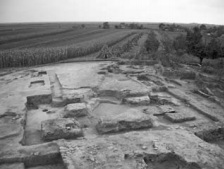The location in the village of Majdan can be connected with the monastery of St. George, who according to the Great Gelert legend founded Chanad around 1030 with the Greek monks. The sources confirm some allegations that the monastery was later taken over by Benedictines. In written sources from 1247, it appears as Wruzlamus munusturu; 1340 years as Orozlanus – munus. As a settlement it is mentioned in earlier sources from the year 1000 as Orozlanus, Orozlanos.
The first archaeological research was carried out after the Second World War, by the City Museum from Kikinda. Unfortunately, the documentation on this research has not been saved. In 1996 and 2003, smaller sondy research was carried out on the northern and eastern slopes of the elevation, and at the highest elevation angle, where the largest concentration of shots was investigated with an area of 16 m2, where the foundations of the building were inscribed with bricks and lime plaster. On the eastern and northern slopes, 79 medieval graves were explored. Jewelry and money in graves timed to the necropolis in the second half of the 11th and the beginning of the 12th century.
In 2004 and 2005, a wide excavation examined the area on the central part of the elevation, on which remains of the foundations of the Romanesque church and the younger Gothic church were discovered. From the Romanesque church, remains of the foundations of the two bell towers and remains of the foundations of the arches on the north and south walls were discovered. The foundations are made of bricks laid in yellow mud, through which a coating of lime mortar begins where the walls begin. On the bricks are the impressions of the lions, asses, the Greek letter of omega and tower. Rare pieces of marble plastic indicate that the doorposts and backpacks are made in ornamental marble.
REMAINS OF ST. GEORGE’S MONASTERY


0 comments on “REMAINS OF ST. GEORGE’S MONASTERY”